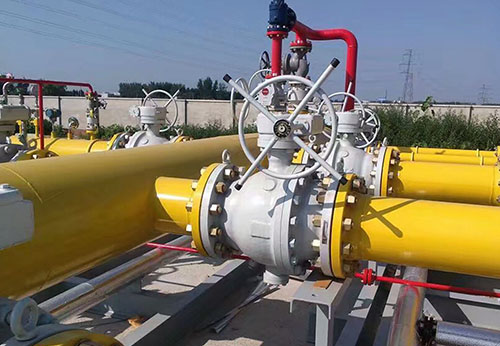What are the applications of valves in gas engineering?
Posted by Bundor valve
As a key component in the gas system, valves play an indispensable role. They play an important role in control and safety assurance in all aspects of gas transmission, storage, distribution and use. This article will discuss several common valve applications in gas engineering.

I. Valves in the transmission pipeline
1. Shut-off valve: Installed at the starting and ending points and branching points of long-distance gas transmission pipelines, used to quickly cut off the flow of gas during pipeline maintenance, inspection or emergency situations to prevent the spread of accidents.
2. Regulating valve: Set between the high-pressure transmission pipeline and the urban gas distribution network to adjust the gas pressure and ensure the safety of gas use for downstream users.
3. Safety valve: When the pipeline pressure rises abnormally, the safety valve automatically opens to release part of the gas to prevent the pipeline and equipment from being damaged due to overpressure.
II. Valves in storage facilities
1. Inlet and outlet valves: Connect gas storage tanks or underground gas storage reservoirs with transmission pipelines to control the filling and output of gas to ensure that the storage volume meets demand.
2. Pressure balancing valve: Maintain the internal pressure of the gas storage facility to stabilize and avoid the risk of equipment damage or leakage due to excessive pressure fluctuations.
3. Emergency shut-off valve: When leaks, fires and other emergencies are detected, the gas source is quickly cut off to prevent the accident from expanding.
III. Valves in the urban distribution system
1. Pressure regulating valve: Installed on the urban gas distribution network, it adjusts the gas pressure in different areas to ensure stable pressure at the user end.
2. Flow control valve: Adjust the gas flow according to user needs to achieve a balance between supply and demand and avoid waste and shortages.
3. User-end valve: Installed on the user's inlet pipe, it is convenient for users to turn on and off the gas. It is also an important control point for gas companies to read meters and conduct safety inspections.
With the advancement of technology, the application of intelligent valves and remote monitoring systems is becoming more and more extensive, and the role of valves in gas engineering will become more intelligent and efficient.

I. Valves in the transmission pipeline
1. Shut-off valve: Installed at the starting and ending points and branching points of long-distance gas transmission pipelines, used to quickly cut off the flow of gas during pipeline maintenance, inspection or emergency situations to prevent the spread of accidents.
2. Regulating valve: Set between the high-pressure transmission pipeline and the urban gas distribution network to adjust the gas pressure and ensure the safety of gas use for downstream users.
3. Safety valve: When the pipeline pressure rises abnormally, the safety valve automatically opens to release part of the gas to prevent the pipeline and equipment from being damaged due to overpressure.
II. Valves in storage facilities
1. Inlet and outlet valves: Connect gas storage tanks or underground gas storage reservoirs with transmission pipelines to control the filling and output of gas to ensure that the storage volume meets demand.
2. Pressure balancing valve: Maintain the internal pressure of the gas storage facility to stabilize and avoid the risk of equipment damage or leakage due to excessive pressure fluctuations.
3. Emergency shut-off valve: When leaks, fires and other emergencies are detected, the gas source is quickly cut off to prevent the accident from expanding.
III. Valves in the urban distribution system
1. Pressure regulating valve: Installed on the urban gas distribution network, it adjusts the gas pressure in different areas to ensure stable pressure at the user end.
2. Flow control valve: Adjust the gas flow according to user needs to achieve a balance between supply and demand and avoid waste and shortages.
3. User-end valve: Installed on the user's inlet pipe, it is convenient for users to turn on and off the gas. It is also an important control point for gas companies to read meters and conduct safety inspections.
With the advancement of technology, the application of intelligent valves and remote monitoring systems is becoming more and more extensive, and the role of valves in gas engineering will become more intelligent and efficient.
 简体中文
简体中文 Русский
Русский Español
Español Bundor - Butterfly, Gate, Check, Ball, Globe Valve Manufacturer, Supplier & Distributor
Bundor - Butterfly, Gate, Check, Ball, Globe Valve Manufacturer, Supplier & Distributor
